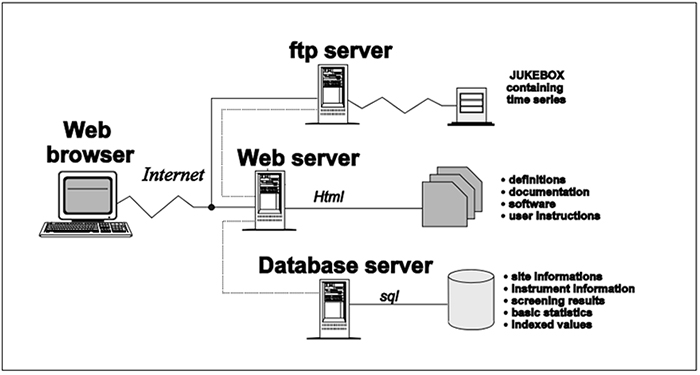“I have worked at DTU for 44 years", Kurt Schaldemose Hansen tells, “and in 1996, I and colleagues started to organise and publish available wind data from sites all over the world.” All these years of work have summed up to more than 195,000 hours of wind speed measurements from 62 sites and more than 1,000,000 hours of wind resource measurements, representing 40 sites around the globe.
From 2006, these data found a home at winddata.com - a website managed by DTU Wind Energy, accessible from any web browser. The service provided access to documentation and user information in html through the web server, but also to site and instrument information and wind measurement (raw and processed data) in sql format, stored in a database. More than 100 GB of the data were placed on a disc-reading jukebox in Kurt’s office (accessed through an ftp server, se figure below). Danish users or other partners could obtain access to most of the data for free, while other could gain access through a Paypal subscription.

The value of wind
The need for wind farms to supply the growing demands for green energy has increased the value of the winddata.com database. The data from geographically diverse sites can support the planning of wind farms around the globe. Time series of wind fluctuations are intended for wind (turbine) design purposes, where simulations are an integral part of such developments. Some of the data are under non-disclosure agreements with commercial partners or other collaborators and can only be accessed under contractual agreement.
“When I saw the time for my retirement approaching” Kurt says, “was when we started looking for a long-lasting and future-proof solution for the database.”
The transition to a FAIR database
DTU Wind Energy benefits from an active approach to handling research data according to the FAIR principles. “We quickly realised that the FAIR principles is an excellent framework to support the criteria for the new database”, Kurt explains and lists these:
- Global and persistent findability, but also discovery through winddata.com, a solid brand for quality wind data
- All data should have clear accessibility criteria
- Interoperable file formats should be used for the data
- Data should be reusable through detailed documentation and by clear copyright information
- Easy citation of specific dataset
- Low maintenance
"With the help from DTU Library, we have now developed a database in a low maintenance structure"
Kurt Schaldemose Hansen
“With the help from DTU Library, we have now developed a database in a low maintenance structure, where the responsibility for the actual dataset is placed in our institutional data repository, DTU Data“, Kurt explains. “DTU Data supports FAIR data, since datasets are globally discoverable, provided at DOI for persistent access and we can share the data with an open license that specifies usage rights. Confidential data can still be FAIR, since they have a metadata record and the possibility for access is clearly defined in the metadata.”
Next figure provides an overview of the content of the new winddata.com database. Datasets and embedded metadata are published in Collections at DTU Data, which is run and maintained by DTU Library. Pertaining documentation about the geographical site is available at the GitLab instance of DTU Wind Energy. Winddata.com also redirects to a landing page here. Datasets and documentation are linked and updates or new datasets can easily be handled on both platforms.

All datasets had to be converted to NetCDF, packed ASCII or csv files and linked to the proper documentation – a process still ongoing. Therefore, the resources and years of work that Kurt and his colleagues already have put in the database are not yet completely placed securely and accessibly under the responsibility of DTU and DTU Wind Energy.
“You don’t stop so close to the finish line”, Kurt, who is now emeritus, laughs, “but actually, we are not just securing old, but valuable dataset. We are adding data to the future of wind energy – and creating a platform for new projects at DTU Wind Energy.”